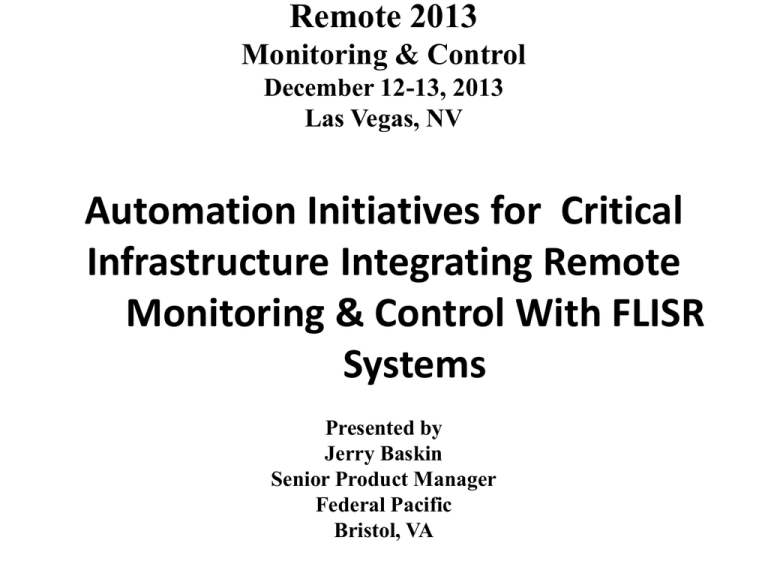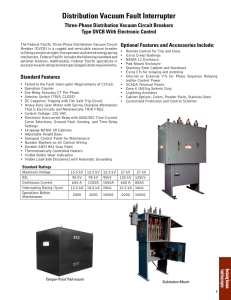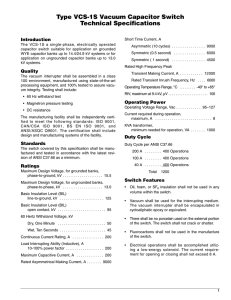Automation Initiatives for Critical Infrastructure Integrating Remote
advertisement

Remote 2013 Monitoring & Control December 12-13, 2013 Las Vegas, NV Automation Initiatives for Critical Infrastructure Integrating Remote Monitoring & Control With FLISR Systems Presented by Jerry Baskin Senior Product Manager Federal Pacific Bristol, VA Automation Components Automation Solutions Automation Components Critical for Interoperability Switches Protective Devices Insulation Mediums Operating Mechanisms Relays & Communications Circuit Interruption Every Circuit Interrupting Device Must Do 3 Things 1. Elongate the arc 2. Confine the arc 3. Cool the arc Circuit Interruption There are two types of Air-Insulated Switches 1. Ablative Interrupters a. Develop a gas by consuming material of arc compressor b. Consuming itself, they have limited life 2. Puffer Interrupters a. Uses renewable source of air to cool the arc b. Has longer life, since air is renewable Circuit Interruption Vacuum Interrupters have longer life and are: 1. 2. 3. 4. Insulated in Air Insulated in SF6 Insulated in Liquid Insulated in Solid-Dielectric Materials a. Rubber b. Cycloaliphatic Epoxy Switches Ablative Puffer Vacuum Switches Ablative Puffer Vacuum Protective Devices Fuses a. Current-Limiting b. Expulsion Vacuum Fault Interrupters Fuses and Vacuum Fault Interrupters Expulsion Current-Limiting Fuses Vacuum Fault Interrupters Insulation Mediums Liquid Dielectrics SF6 Gas Solid Dielectrics Air-Insulated Insulation Mediums Liquid Dielectrics 1. 2. 3. 4. Vegetable Oil Mineral Oil Non-Flammable Bio-degradable At Some Temperature they will Burn Electric Arcs Can reach a Temperature to 30,000°C -- A Fault Event in the Liquid Dielectric -- A Fire or Heavy Smoke as a Minimum will occur -- Regardless of what is said, HAZMAT will make you dig dirt Insulation Mediums Liquid Dielectrics •Issues associated with liquid dielectrics -Environmental (soil contamination associated with leaks) -Cost and depletion of natural resources -Personal safety issues associated with fire generation during breakdown of liquid dielectric -Handling necessary to maintain integrity of the dielectric -Visual inspection to verify presence of adequate dielectric -Testing to verify integrity of the dielectric -Weight of the dielectric impacts on support structure Insulation Mediums Gas Dielectrics Over the last 20 years there has been diminished interest in liquid and a very positive move to gas-insulated switchgear by both industrial/commercial and utility markets. Insulation Mediums SF6 • Worst Greenhouse Gas • Develops 15 Carcinogenic Materials when Arc Interrupts in SF6 • It will Leak and Requires Monitoring and Refill • Refill Must be Accomplished Without Introducing Contamination Insulation Mediums SF6 • No Field Maintenance Possible Except Refilling of Gas • Annual Reporting Requirement of SF6 Emissions to Federal Government • DOD Policy is now to avoid SF6 at all Military Installations Insulation Mediums Solid Dielectrics • Rubber and epoxies may present detrimental impact on the environment • May have a hidden potential to develop disruptive failures if manufactured with small voids • Materials do not biodegrade in any reasonable time frame and are therefore materials that are harmful to the environment Insulation Mediums Solid Dielectrics • These compounds require considerable energy to manufacture, consuming resources • Solid-dielectric materials typically are employed to encapsulate vacuum Interrupters • Encapsulated interrupters have not been successfully integrated with a visible disconnect • Compromise the operational security and ease of operation afforded by insulation in air • Preserves the size reduction inherent with the gas and liquids Insulation Mediums Air –Insulated • Air as an insulating medium is replenishable and self-renewing • Avoids the inherent hazards associated with every other insulating medium • Air is a naturally occurring compound that does not deplete or consume other energy resources in its production. • An air-insulated electrical component does not require a refill valve, a pressure indicator or a volume level gauge. • Air involved in an electrical arc does not develop any hazardous properties. • Air is the most economical insulating medium. Insulation Mediums Air-Insulated • Air is the ultimate green-energy technology for switching and protection on electrical power distribution circuits. • Air is an environmentally neutral medium, it is successfully used in the widest range of applications to provide insulating properties that are fully effective when combined with appropriate design controls. • In-air insulation, manifested in the vacuum interrupter technology, provides the visible open gap not offered by most other varieties of switchgear with vacuum interrupter technology. • Each group-operated vacuum interrupter is integrated with a three-pole, group-operated visible disconnect. Insulation Mediums Air-Insulated • Allows Visible Disconnect • Vacuum Interrupter Mechanically and Electrically interlocked with the visible disconnect • Disconnect cannot be opened until after the vacuum interrupter has opened to interrupt the circuit • Interlocking makes certain that the vacuum interrupter cannot be closed until after the visible disconnect is closed. Insulation Mediums Air-Insulated Eliminating reliance on liquid (oil), gas (sulpur hexafluoride -- SF6), and solid materials (rubber and epoxy) as encapsulating and insulating materials, and utilizing air as a dielectric medium in a controlled environment, vacuum interrupter switchgear is the leading-edge green technology revolutionizing distribution system reliability while providing unsurpassed operational flexibility. Operating Mechanisms Run-and-Trip Fast Trip Magnetic Latch Magnetic Actuators Operating Mechanisms Run-and-Trip Operating Mechanisms Fast Trip Operating Mechanisms Magnetic Latch Induced Field Actuates Spring-Loaded Plunger Magnetic-Latch Plunger Trip Lever Operating Mechanisms Magnetic Actuators Induced Field Magnetizes Concentric Actuators In Base Relays Self-Powered Relays Relays Requiring Control Power Relays with Communications The Self-Powered Relay The Magnetic Latch The Relay The Current Transformer Relays Requiring Control Power Relays with Communications Communication Components Seamless and Secure Ethernet Switch (MM Fiber) Communication Protocol Converters Control Power & Sensors Automation Solutions Remote Supervisory Control Automatic Source Transfer Automatic Sectionalizing Remote Supervisory Control Hardwire Radio Fiber Optic Remote Supervisory Control Remote Supervisory Control Automatic Source Transfer Totally Self-Contained Remote Capable Automatic Source Transfer Automatic Source Transfer Automatic Source Transfer Relays with Pre-programmed Automatic-Transfer Scheme Automatic Sectionalizing Switching & Protection Package Control Package Vacuum Interrupter with In-Line Visible Disconnect Lets Look at Automated Switching and What it Offers. The so-called SMART GRID. First, three Terms you will want to know: Vacuum Interrupter with In-Line Visible Disconnect Lets Look at Automated Switching and What it Offers. The so-called SMART GRID. First, three Terms you will want to know: SAIDI Vacuum Interrupter with In-Line Visible Disconnect Lets Look at Automated Switching and What it Offers. The so-called SMART GRID. First, three Terms you will want to know: SAIDI – System Average Interruption Duration Index Vacuum Interrupter with In-Line Visible Disconnect Lets Look at Automated Switching and What it Offers. The so-called SMART GRID. First, three Terms you will want to know: SAIDI – System Average Interruption Duration Index SAIFI Vacuum Interrupter with In-Line Visible Disconnect Lets Look at Automated Switching and What it Offers. The so-called SMART GRID. First, three Terms you will want to know: SAIDI – System Average Interruption Duration Index SAIFI – System Average Interruption Frequency Index Vacuum Interrupter with In-Line Visible Disconnect Lets Look at Automated Switching and What it Offers. The so-called SMART GRID. First, three Terms you will want to know: SAIDI – System Average Interruption Duration Index SAIFI – System Average Interruption Frequency Index FLISR Vacuum Interrupter with In-Line Visible Disconnect Lets Look at Automated Switching and What it Offers. The so-called SMART GRID. First, three Terms you will want to know: SAIDI – System Average Interruption Duration Index SAIFI – System Average Interruption Frequency Index FLISR – Fault Location Isolation and Self Restoration Vacuum Interrupter with In-Line Visible Disconnect Automation Products SCADA Controlled Automatic Transfer FLISR Automatic Sectionalizing Self-Restoring Self-Healing All help utilities improve the SAIDI and SAIFI scores, which are performance measures Public Utility Commissions use to establish rate increases to be allowed for the utility to recover capital equipment investment. Case 1 Sectionalizing Faults on a Typical Open Loop Implemented with Manual Switches Case 1 Typical Manual Open Loop Normal Condition: Each half of the loop is served by its normal red or green source (remember there are many more units on these red and green feeders) Case 1 Typical Manual Open Loop Fault at X X Case 1 Typical Manual Open Loop Produces immediate overcurrent stress and under-voltage condition on all components up to the location of the fault; Loss of voltage on all components beyond the fault up to the open point APVE-3 APVE-3 X Represents a very simplified System – Typically more open loops off these two feeders. Case 1 Typical Manual Open Loop The source breaker opens with resulting loss of voltage to all loads on the red circuit (including parallel red circuits) Case 1 Typical Manual Open Loop Crews are dispatched: a. to locate and isolate the faulted section; b. to close the normally open switch; and c. then the source breaker is closed to pick up the load that was lost The sequence takes a minimum of 45 minutes to 60 minutes Case 1 Typical Manual Open Loop If say 1000 customers on this feeder lost power for 45 minutes = 45,000 min. or outage of 750 hours Case 2 Vacuum Interrupter with Overcurrent Relay installed in the first Pad-Mounted Unit of each Loop Section and relayed to Open on any fault on its section up to the normally open point Case 2 Typical Manual Open Loop Normal Condition: Each half of the loop is served by its normal red or green source Case 2 APVE-3 APVE-3 Typical Manual Open Loop Fault at X X Case 2 Typical Manual Open Loop APVE-3 APVE-3 With fault at X Power is lost to the PVE-9 at the bottom left X Case 2 Typical Manual Open Loop The vacuum interrupter in the first unit of the Loop operates immediately, dropping all load on that section of the loop Case 2 Typical Manual Open Loop Manual switching is performed to isolate the faulted section and restore power to the extent possible by closing the normally open switch Outage time for the affected section is about the same but the number of customers and the frequency are reduced significantly. Case 2 Open Loop with a Vacuum Interrupter with Overcurrent Relay at each tap Only 500 customers on the affected feeder lost power for 45 minutes = 22,500 min. or outage of 375 hours Case 3 FLISR Automatic Sectionalizing Switches Response to Faults Vacuum Interrupter with In-Line Visible Disconnect FLISR Automatic Sectionalizing Self-Healing Schemes Self-Restoring Schemes Normal condition is illustrated with peer-to-peer communication between each adjacent Vacuum Interrupter, including at the normal open Point or with the substation breaker Vacuum Interrupter with In-Line Visible Disconnect FLISR Automatic Sectionalizing Self-Healing Schemes Self-Restoring Schemes Fault at X X Vacuum Interrupter with In-Line Visible Disconnect FLISR Automatic Sectionalizing Self-Healing Schemes Self-Restoring Schemes Vacuum Interrupter Action: #4 above the fault sees the overcurrent; Vacuum Interrupter #5 below the fault does not see the overcurrent; They communicate these facts to each other and the algorithm identifies the fault as between them; The loss of voltage at Vacuum Interrupter #5 is identified by the Normally Open Vacuum Interrupter #6 on the Green circuit, establishing that there is an outage above Vacuum Interrupter # 5 4 X 5 6 Vacuum Interrupter with In-Line Visible Disconnect FLISR Automatic Sectionalizing Self-Healing Schemes Self-Restoring Schemes With the foregoing intelligence, communicated among all the Vacuum Interrupters and to the substation breakers, the FLISR algorithm is initiated. 4 X 5 6 Vacuum Interrupter with In-Line Visible Disconnect FLISR Automatic Sectionalizing Self-Healing Schemes Self-Restoring Schemes FLISR algorithm initiates operations: Vacuum Interrupter #4 above the fault opens; Vacuum Interrupter #5 below the fault opens; the faulted cable is isolated; Vacuum Interrupter #6 receives these communications and closes; Service is restored to the extent possible 4 5 6 Vacuum Interrupter with In-Line Visible Disconnect FLISR Automatic Sectionalizing Self-Healing Schemes Self-Restoring Schemes The number of customers affected is minimized The duration of the outage is minimized Total outage time is probably less than 10 seconds, depending on time delay for coordination For a 1,000 customers that’s only 167 minutes outage per occurrence 4 5 6 Vacuum Interrupter with In-Line Visible Disconnect FLISR Automatic Sectionalizing Self-Healing Schemes Self-Restoring Schemes In this case, there are only say 250 customers out for 10 seconds = 2500 seconds or 41.7 minutes 4 X 5 6 Relative Comparison of Outages For Different Levels of Automation Number of Customers Affected Duration Of Outage Customer Outage Hours 1000 45 minutes 750 One Vacuum 500 Interrupter at each feeder tap 45 minutes 375 One Vacuum 250 Interrupter at every Sectionalizing Point 10 seconds 0.7 Manual Relative Comparison of Outages For Different Levels of Automation Number of Customers Affected Duration Of Outage Customer Outage Hours 1000 45 minutes 750 One Vacuum 500 Interrupter at each feeder tap 45 minutes 375 One Vacuum 250 Interrupter at every Sectionalizing Point 10 seconds 0.7 Manual Thank You Remote 2013 Monitoring & Control For this Opportunity and it is Hoped that the Presentation has been Informative


